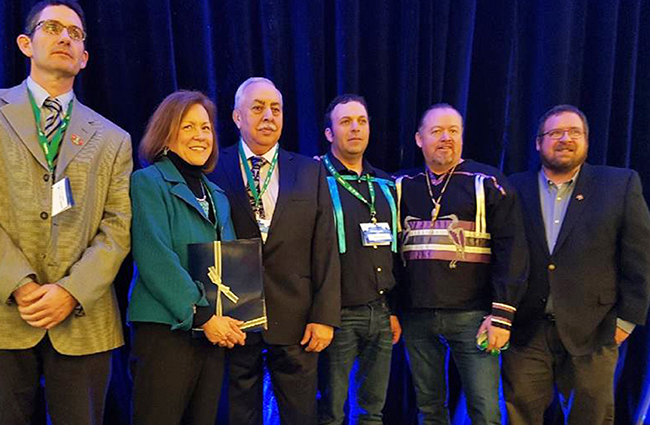Gold for Nipissing First Nation fishery vision

By Kelly Anne Smith
Nipissing First Nation has been awarded gold for efforts to heal Lake Nipissing’s walleye. There are now more spawning male and female walleye and the abundance of adult walleye has noticeably increased.
Nipissing First Nation received the IPAC Gold Award for their leadership along with the Ministry of Natural Resources and Forestry for the joint stewardship of Lake Nipissing in Toronto. Entries were received nation wide.
Chief Scott McLeod was in Toronto to receive the Public Leadership Award with Councillors Brian Couchie and Corey Goulais and CEO Dwayne Nashkawa.
The Institutions of Public Administration of Canada (IPAC) and Deloitte recognized the outstanding leadership and innovation of reaching the Memorandum of Understanding between Nipissing First Nation and the Ministry of Natural Resources and Forestry (MNRF) which recognized rights and interests of both governments.
A report showcasing inspirational leadership leads with the Anishinabek having fished
Lake Nipissing’s waters since time immemorial. The conclusion calls for similar collaborations across Canada to successfully mimic that of the NFN/MNRF.
There has been a dilemma enforcing provincial laws to help Lake Nipissing grow healthy while balancing the Treaty rights of Anishnaabe commercial fisherpersons.
Innovation and leadership are behind the award says Chief McLeod. “It’s about the creative work that we did trying to determine how we were going to get around some of the obstacles that were handcuffing us to fully enforce and recognize First Nation law. At the same time, recognizing provincial laws toward the fishery and how we were going to work together to resolve those issues and those gaps. We could both collaboratively work together to manage the fishery without jeopardizing any rights while working within the parameters of provincial legislation.”
The Chief says the award is to recognize the relationship. “We’ve used positive relationships to solve really conflicting problems. It’s not really based on the report card of what we’ve done with the fishery. That is an added benefit.
It’s more about working through complications we’re challenged with and coming up with creative new ideas to circumvent those issues.”
The Lake Nipissing Fishery: Strategic Collaboration on a Shared Resource of Assessments states forty years of sport and commercial fishing on Lake Nipissing led to tensions over regulations. “By 2012 the walleye population has plummeted to near collapse with the almost total absence of reproducing adult fish.”
The report points to legal precedence in the 2004 Nipissing First Nation Gchi-Naaknigewin (Constitution or Great Law) which documents its Fisheries Law and The Commanda case confirming Nipissing First Nation’s right to fish commercially.
Nipissing First Nation’s Chief and Council voted to close the commercial fishing season early in 2015, just seven weeks after they were elected.
The 2017 fisheries assessment data reports an improvement in fish health.


